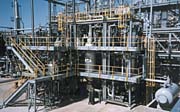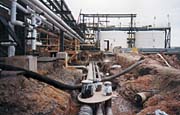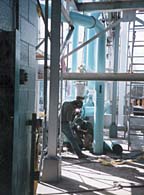The term "process piping" generally refers to piping systems that convey chemicals under pressure or vacuum. It also is used to describe utility piping systems that are used in, or in support of, a chemical process, such as plant water. Also, certain drainage piping--where corrosive or toxic fluids are being transported and severe conditions may be present, or where it is simply outside the scope of plumbing codes--is also sometimes classified as process piping. Some places where process piping is used are obvious, such as chemical and petrochemical plants, petroleum refineries, pharmaceutical manufacturing facilities and pulp & paper plants. However, there are many other not so obvious places where process piping is commonplace, such as semiconductor facilities, automotive and aircraft plants, water treatment operations, waste treatment facilities and many others.

Complex process piping arrangements shown in a hydrogenation reaction unit at an ibuprofen manufacturing facility.
ASME Process Piping Codes
In North America, the code that governs the design, fabrication, component standards, installation, inspection and testing of process piping is the ASME B31.3 Process Piping Code. This code is also an ANSI standard and is a subset of the ASME Code for Pressure Piping, B31. The ASME B31 Code for Pressure Piping consists of a number of individually published sections, each an American National Standard. The ASME B 31.3 Code is mandated by law in Canada, is a requirement in the U.S. according to OSHA for all process piping, and is further mandated by many industrial insurance carriers for industrial facilities. There is a lot of misconception regarding the application of this code, particularly in facilities such as semiconductor plants and others where nonmetallic piping is prevalent. In fact, many engineers, owners and contractors are mistakenly under the impression that it does not apply to systems that involve thermoplastic and FRP piping. However, make no mistake; the B31.3 Code is the first document that attorneys will reference when there is an accident or injury involving process piping. When it comes to process piping, this is the only code that exists in the Western Hemisphere, and it does cover all materials.
The ASME B31.3 Process Piping Code excludes piping designed for internal gauge pressure at or above zero but less than 15 psi (105 kPa), provided the fluid is nonflammable, nontoxic, and not damaging to human tissue, and its design temperature is from -20 degrees F (-29 degrees C) and 366 degrees F (186 degrees C). In other words, if piping is between 0 and 15 psig (105 kPa), it can still be governed by the rules of the code if the material being conveyed is flammable or toxic or damaging to human tissue. Also excluded from the code is internal piping of fired heaters; packaged equipment such as heat exchangers, pressure vessels or other processing equipment; as well as piping related to boilers (which is typically governed by the B31.1 Power Piping Code).
Codes vs. Standards
One common misperception is that if nonmetallic process piping systems utilize components and installation procedures that conform to some ASTM standards, then the ASME B31.3 Code is somehow irrelevant. At the heart of this misperception is confusion over what a code is and what a standard is. A standard, such as ASTM mandates, typically covers the manufacture of specific components or installation techniques, which make up only a part of a system. A code, on the other hand, covers an entire system from design to installation and testing, and references which standards (e.g. ASTM Standards) are approved or listed by that code. Thus, a code is more encompassing than a consensus standard and does not replace a standard, but explains how to incorporate that standard into a functioning system.
Materials of Construction
As for what materials of construction can be utilized in a process piping system, there is an almost limitless selection of metallic, nonmetallic and nonmetallic-lined metallic materials to choose from. The fluid services to be handled will dictate the material requirements. Metallic materials typically include various grades of carbon steel, low and intermediate alloy steels, austenitic stainless steels, duplex stainless steels, and for more corrosive applications, nickel and its alloys, and titanium and its alloys. Requirements for metallic materials are listed in Chapter 3 of the B 31.3 Code. Nonmetallic materials typically include thermoplastic materials, reinforced thermosetting resin materials (commonly called FRP or fiberglass), thermoplastic or glass-lined metallic piping, and in some specialized pharmaceutical research applications, borosilicate glass piping.
The advantages of thermoplastic piping and reinforced themosetting resin (RTR) piping systems are that they are highly corrosion resistant to very aggressive compounds and usually cost effective from an overall installed cost consideration. There are some limitations placed on nonmetallic piping, however. For instance, thermoplastic piping is not allowed in flammable fluid service above ground (although thermoplastic-lined metallic piping is permitted) and should be safeguarded when used in hazardous fluid services. PVC and CPVC are specifically prohibited from use in compressed gas services of any kind. RTR, borosilicate glass and porcelain piping are required to be safeguarded when used in toxic or flammable fluid services.
Typical thermoplastic piping includes the vinyls (PVC, CPVC), the polyolefins (high-density polyethylene or HDPE, and polypropylene), and the fluoropolymers (PVDF, VF2/HFP copolymer or Kynar(R) Flex, ECTFE), and the various grades of fully fluorinated polymers more commonly referred to as Teflon(R) (PFA and FEP). The common RTR materials include glass-reinforced epoxy, glass-reinforced vinyl ester, and the more exotic glass-reinforced furan. The most common plastic-lined metallic piping includes both steel and austenitic stainless steel materials lined with polypropylene, Kynar(R) Flex, ECTFE, ETFE or Tefzel(R), and Teflon(R) (PFA, FEP and PTFE). In pharmaceutical and fine chemicals processing, ceramic-lined steel is also quite common for high temperature corrosive services.
Qualifications of the Designer
According to the Process Piping Code, the designer of a process piping system must be experienced in the use of the code. The exact qualifications and experience required of the designer depend on the complexity and criticality of the system. The designer should either have a four-year engineering degree plus five years of experience, a two-year engineering associates degree and 10 years of experience, a Professional Engineering registration and pressure piping experience, or 15 years of experience in the design of related pressure piping. If the designer of record does not meet any of these criteria, then they would require the approval of the owner to serve as the designer of record.

Dual containment polypropylene process sewers and dual containment FRP process waste lines being installed at an inorganic pigment manufacturing facility.
Design Criteria
Aside from material selection based on fluid service, some of the basic factors that the designer has to consider for a process piping system include the design pressure; design temperature; design minimum temperature; various ambient effects such as cooling, fluid expansion, and atmospheric icing; dynamic effects such as impact, wind, earthquake, vibration and discharge reactions; weight effects; live loads; thermal expansion and contraction effects (including thermal loads due to restraints, loads due to temperature gradients and differential expansion effects); effects of support, anchor and terminal movements; reduced ductility effects; cyclic effects; and lastly, air condensation effects.
Pipe, Valves and Fittings
The so-called listed pipe, valve and fitting components (those standards that are listed by the code) are contained in Chapter IV of the code for metallic components and in Chapter VII for nonmetallic components. Other components can be used that are not listed; however, they must meet certain criteria. For an unlisted component or element to be used in a process piping system, its pressure design must be proven by calculations consistent with the code and shall further be substantiated by one or more means. These means include extensive, successful service under comparable conditions, experimental stress analysis, proof testing, or detailed stress analysis (e.g. finite element analysis).

Welders welding carbon steel piping for plant water in a pharmaceutical process plant.
Fabrication and Assembly
Chapter V of the code covers the requirements for fabrication, assembly and erection of metallic piping systems. This includes the requirements for the qualification of welding procedures and the qualification and training requirements for welders. There are detailed requirements stated for all of the various steps in fabrication and assembly, including preheating requirements and heat treatment requirements after welding. Bending and forming requirements are also covered, as are detailed requirements for assembly and erection (e.g. flange and threading procedures). Chapter VI of the code covers all of the requirements for inspection, examination and testing, including such items as required visual tests; pressure testing requirements; radiography; ultrasonic, magnetic particle and liquid penetrant examination requirements; and acceptance criteria. Unless otherwise specified in the design, the code requires a minimum retention of records for at least five years after a record is generated for a project.
Chapter VII of the code is essentially a miniature code unto itself and covers all of the requirements for nonmetallic piping within this one chapter. One notable difference in nonmetallic piping systems with respect to assembly and erection criteria is that individuals performing bonding (making of thermoplastic joints by any means) must be requalified if they have not performed a specific bonding process within a six-month period, or if there is specific reason to question the individual's ability to make nonmetallic joints under the specific bond qualification procedure. This requirement exists mostly due to the fact that a vast majority of problems with the use of nonmetallic piping has occurred in the past due to problems in the installation of these materials.
Conclusion
In closing, the ASME B 31.3 is the only accepted code that exists for process piping systems. It is directly required by law in Canada and indirectly in the U.S. by means of OSHA process safety requirements and insurance mandates. However, the fact that the code is required should not be the only reason to compel users to follow it. If followed, it is an excellent means to insure the safe, reliable installation of process piping, as evidenced by the excellent record that exists in chemical plants and petroleum refineries throughout North America.
